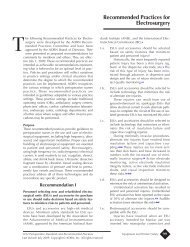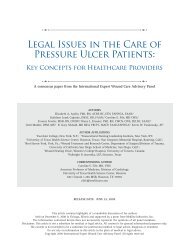2009 CAUTI guidelines - Centers for Disease Control and Prevention
2009 CAUTI guidelines - Centers for Disease Control and Prevention
2009 CAUTI guidelines - Centers for Disease Control and Prevention
Create successful ePaper yourself
Turn your PDF publications into a flip-book with our unique Google optimized e-Paper software.
I. Executive SummaryThis guideline updates <strong>and</strong> exp<strong>and</strong>s the original <strong>Centers</strong> <strong>for</strong> <strong>Disease</strong> <strong>Control</strong> <strong>and</strong> <strong>Prevention</strong>(CDC) Guideline <strong>for</strong> <strong>Prevention</strong> of Catheter-associated Urinary Tract Infections (<strong>CAUTI</strong>)published in 1981. Several developments necessitated revision of the 1981 guideline, includingnew research <strong>and</strong> technological advancements <strong>for</strong> preventing <strong>CAUTI</strong>, increasing need toaddress patients in non-acute care settings <strong>and</strong> patients requiring long-term urinarycatheterization, <strong>and</strong> greater emphasis on prevention initiatives as well as better defined goals<strong>and</strong> metrics <strong>for</strong> outcomes <strong>and</strong> process measures. In addition to updating the previousguideline, this revised guideline reviews the available evidence on <strong>CAUTI</strong> prevention <strong>for</strong>patients requiring chronic indwelling catheters <strong>and</strong> individuals who can be managed withalternative methods of urinary drainage (e.g., intermittent catheterization). The revised guidelinealso includes specific recommendations <strong>for</strong> implementation, per<strong>for</strong>mance measurement, <strong>and</strong>surveillance. Although the general principles of <strong>CAUTI</strong> prevention have not changed from theprevious version, the revised guideline provides clarification <strong>and</strong> more specific guidance basedon a defined, systematic review of the literature through July 2007. For areas where knowledgegaps exist, recommendations <strong>for</strong> further research are listed. Finally, the revised guidelineoutlines high-priority recommendations <strong>for</strong> <strong>CAUTI</strong> prevention in order to offer guidance <strong>for</strong>implementation.This document is intended <strong>for</strong> use by infection prevention staff, healthcare epidemiologists,healthcare administrators, nurses, other healthcare providers, <strong>and</strong> persons responsible <strong>for</strong>developing, implementing, <strong>and</strong> evaluating infection prevention <strong>and</strong> control programs <strong>for</strong>healthcare settings across the continuum of care. The guideline can also be used as a resource<strong>for</strong> societies or organizations that wish to develop more detailed implementation guidance <strong>for</strong>prevention of <strong>CAUTI</strong>.Our goal was to develop a guideline based on a targeted systematic review of the best availableevidence, with explicit links between the evidence <strong>and</strong> recommendations. To accomplish this,we used an adapted GRADE system approach <strong>for</strong> evaluating quality of evidence <strong>and</strong>determining strength of recommendations. The methodology, structure, <strong>and</strong> components of thisguideline are approved by HICPAC <strong>and</strong> will be used <strong>for</strong> subsequent <strong>guidelines</strong> issued byHICPAC. A more detailed description of our approach is available in the Methods section.To evaluate the evidence on preventing <strong>CAUTI</strong>, we examined data addressing three keyquestions <strong>and</strong> related subquestions:1. Who should receive urinary catheters?A. When is urinary catheterization necessary?B. What are the risk factors <strong>for</strong> <strong>CAUTI</strong>?C. What populations are at highest risk of mortality related to urinary catheters?2. For those who may require urinary catheters, what are the best practices?Specifically, what are the risks <strong>and</strong> benefits associated with:A. Different approaches to catheterization?B. Different catheters or collecting systems?C. Different catheter management techniques?D. Different systems interventions (i.e., quality improvement programs)?3. What are the best practices <strong>for</strong> preventing <strong>CAUTI</strong> associated with obstructed urinarycatheters?8
















